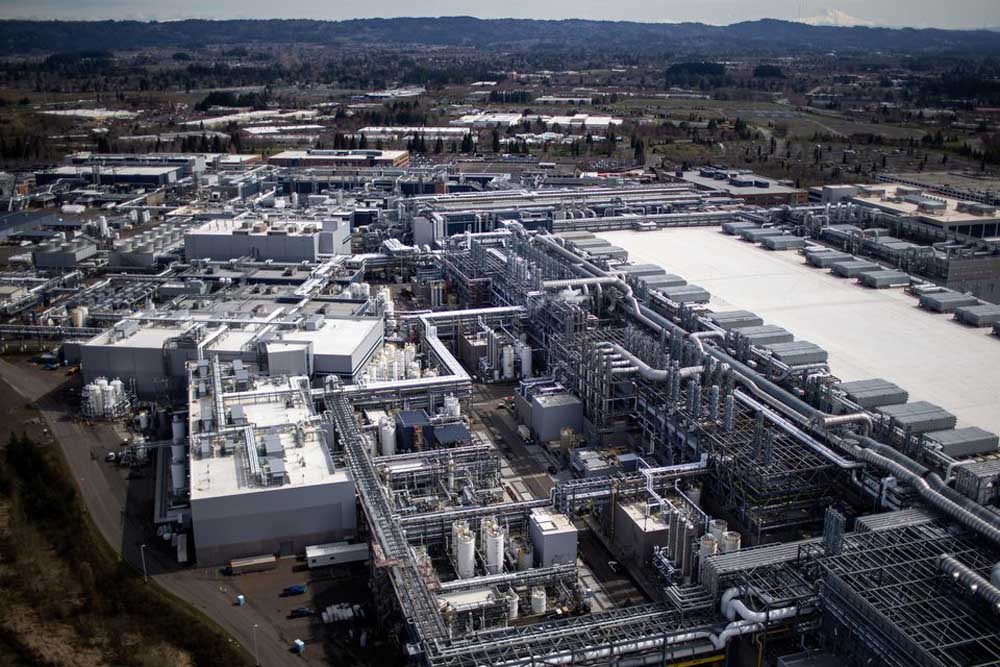Intel plans massive Oregon factory expansion in Hillsboro, filings show
Published 11:15 am Tuesday, August 1, 2023

- Gordon Moore Park at Ronler Acres, Intel’s 450-acre campus in Hillsboro, OR, seen from the air March 27.
Intel plans an enormous upgrade to its Hillsboro research factories over the next five years, according to new filings with state regulators, an expansion that could cement Oregon’s role as the heart of the chipmaker’s technology development.
Plans call for a fourth phase to Intel’s massive D1X factory south of Hillsboro Stadium, and an expansion of its aging D1A factory on the same, 450-acre property. Intel also plans technological upgrades to existing facilities and new manufacturing support investment, according to the filings.
While Intel’s filings don’t put a price tag on the proposals, an expansion on par with prior D1X upgrades would run in the billions of dollars.
That’s less than the tens of billions Intel is putting toward new, high-volume factories in Arizona and Ohio. But it would nonetheless represent one of the biggest capital projects in Oregon history.
It’s likely to add hundreds, or maybe thousands, of workers to Intel’s Oregon workforce. And it commits Intel to years of ongoing investment in maintaining and improving its Oregon research efforts.
Intel didn’t immediately comment Monday on its Oregon filings and expansion plans. But CEO Pat Gelsinger told The Oregonian/OregonLive in May that the company was committed to investing in Oregon for the long term and hinted that the scale of that spending could be quite large.
“I would be reticent to constrain my dreams for how big it might be in the future,” Gelsinger said at the time.
Intel is already Oregon’s largest corporate employer, with 22,000 workers assigned to its factories, labs and corporate offices in Washington County. Its headquarters are in Santa Clara, California, but Intel’s largest and most advanced operations are in Oregon.
An 1,100-page air-quality permit application Intel quietly filed last month with the Oregon Department of Environmental Quality indicates the planned upgrades will take place at the company’s Gordon Moore Park campus, known until last year as Ronler Acres.
Intel’s ambitious Oregon plans come at a difficult time for the chipmaker, which is ceding market share to rivals after a series of manufacturing setbacks cost the company its technological lead. Intel is also lagging in the race to develop new classes of chips for artificial intelligence.
Gelsinger has responded by committing Intel to spend billions of dollars on new factories and technological upgrades. The company is building factories in Arizona, Ohio, Germany and Israel. Amid declining sales, Intel is laying off workers, cutting wages and slashing its investor dividend to help balance the books.
Intel develops each new generation of its manufacturing technology in Oregon, then duplicates the process at its factories around the world. But Oregon’s central role in Intel’s technology development seemed in doubt last year, when the company announced a new manufacturing and research campus near Columbus, Ohio.
The Oregon Legislature responded this year with a $500 million package of tax incentives aimed at encouraging new investment by Intel and other chipmakers. On Monday, Gov. Tina Kotek’s office notified lawmakers of her intent to award Intel $90 million in incentives, the first funding to be designated from this year’s legislation.
The state funding “ensures that Oregon will maintain its status as a world class research hub,” said Anca Matica, the governor’s press secretary. “We look forward to continuing our partnership with Intel in the years to come and seeing positive developments from this investment.”
Sources familiar with Intel’s plans say the company sought the state money to help subsidize the pending Hillsboro expansion. Intel already receives more Oregon tax breaks than any other company, with incentives worth over $200 million annually. Matica said Kotek’s office and Intel are still negotiating over how much of the latest state funding will come through grants and how much will be in the form of loans.
“The Legislature’s work to modernize workforce incentives and make Oregon competitive for federal grants will solidify Oregon’s status as an industry leader,” House Speaker Dan Rayfield, D-Corvallis, said in a written statement Monday. “This will directly result in family wage jobs in every corner of the state creating an economic ripple effect in all of our communities.”
Intel’s July filings with Oregon regulators don’t say how much money the company plans to spend on its latest expansion. Its last upgrade, a third phase at D1X, cost $3 billion and added more than 1 million square feet to the campus. The company opened that third phase last year.
The latest expansion could be even bigger because in addition to the fourth phase to D1X, Intel plans to overhaul a 30-year-old factory called D1A, adding manufacturing support buildings, and make other, unspecified technology upgrades on the campus.
“It is truly amazing news,” said Sen. Janeen Sollman, D-Hillsboro, co-chair of the Legislature’s semiconductor committee. “Oregon’s future economy is looking better and brighter!”
Intel’s voluminous new Oregon filings indicate it expects to install some new equipment as early as 2025 and to complete other work by 2028. It doesn’t indicate when the company plans to start construction or whether it envisions wrapping up the entire project within five years. Prior work on D1X enlisted thousands of construction workers and contractors over three years.
Intel’s environmental applications indicate the company expects a significant increase in air pollution associated with the upgrade. For example, the company is seeking to more than double the increase in the amount of greenhouse gasses it is permitted to emit from Oregon sources. It’s not clear whether those emission increases reflect the scale of Intel’s pending expansion or new technologies that emit more pollution.
The air-quality permit application says increased emissions associated with Intel’s expansion will move the company’s Washington County manufacturing into a federal classification as a “major source” of regulated pollutants.
That triggers additional scrutiny by state and federal environmental regulators. Intel’s application seeks to demonstrate compliance with state and federal laws under that major source classification.
“I’m also happy to see industry and good jobs in our state. We definitely need to see that,” said Mary Peveto, executive director of Neighbors for Clean Air, an Oregon nonprofit that tracks atmospheric pollution and supports efforts to contain it.
While Intel’s pending expansion is welcome news economically, Peveto said it also underscores the need for Oregon to carefully evaluate permit applications and ensure that industry complies with the state’s environmental standards.
“Intel is one of the largest single polluters and this is doubling that,” Peveto said. “We need the resources to make sure communities are protected.”
It’s not clear what is prompting Intel to proceed with its Oregon expansion now. The company might be seeking to capitalize on the state funding approved this spring or a share of $52 billion in federal subsidies for the semiconductor industry that Congress approved last year.
Or Intel might need to update its research factories for new manufacturing technologies, such as extreme ultraviolet lithography. EUV uses light to imprint extremely tiny patterns onto silicon wafers, enabling smaller features on computer chips to improve performance.
Intel is seeking federal funding for a new lithography research center and Gelsinger, along with U.S. Sen. Ron Wyden, are pushing the Biden administration to put the facility in Oregon.






